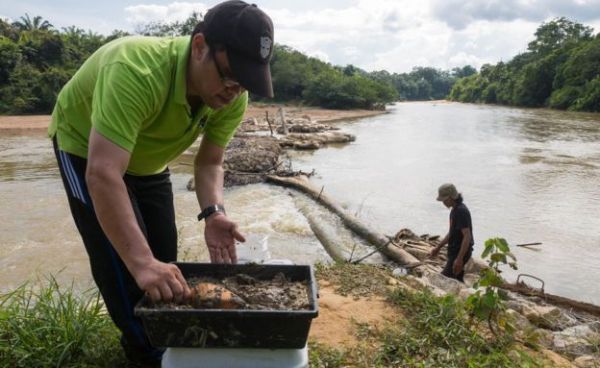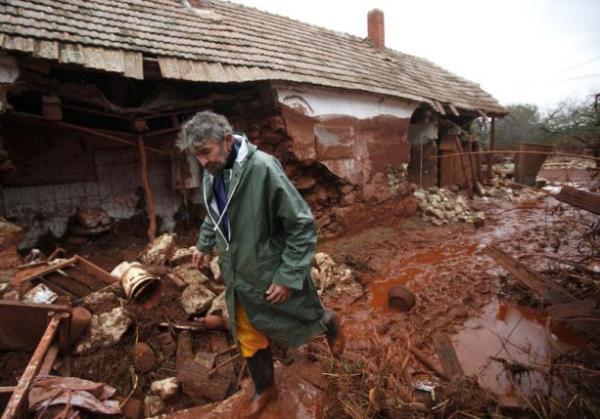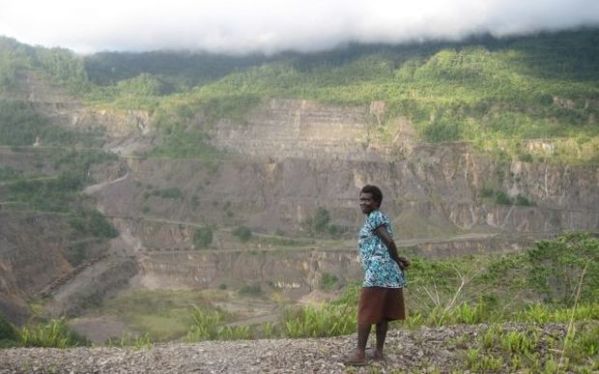
Bauxite mining has become a controversial political issue in Malaysia. As the government implements a temporary ban on extracting the aluminium ore, BBC South-East Asia correspondent Jonathan Head visits the most-affected area.
Amid the monotonous dark green lines of Malaysia’s endless palm oil plantations, there are now vivid red gashes in the hills behind the east coast town of Kuantan.
These have appeared only in the past 18 months, as a frenzy of open-cast bauxite mining gripped Pahang province.
Tonnes of bauxite are being transported out of the region. It is the world’s main source of aluminium so is vital for the construction of everything from airplanes to saucepans and cooking foil.
The numbers are staggering.
Annual output of bauxite ore has increased from a little over 200,000 tonnes in 2013, to nearly 20 million tonnes last year. Malaysia is now the world’s top producer, accounting for nearly half of the supply to China’s massive aluminium industry.
What is bauxite?

- It is an aluminium ore and the world’s main source of aluminium.
- Not a mineral itself, it is a rock comprised mostly of aluminium hydroxide, typically alongside small amounts of silica, iron oxide and other impurities.
- It is used mostly to make aluminium but other uses include making sandpaper, polishing powders, and in hydraulic fracturing, or “fracking”, gas and oil from shale rock.
- There are plentiful reserves of it, which should allow hundreds of years’ more use even before recycling is taken into account.
- The top producers are Australia, China, Brazil and India.
- Commonly found near the surface, it is typically strip-mined – a practice sometimes criticised for its environmental impact.
- The subsequent production of aluminium involves electrolysis and is usually located in countries where electricity is cheap, such as Iceland.
Malaysia has a long history of mining, especially tin, but until very recently it scarcely registered on global markets as a source of bauxite. That changed suddenly in January 2014, when, in an attempt to boost its own aluminium-smelting industry, Indonesia banned exports of bauxite ore.
Up to that point Indonesia had been China’s major supplier.
Several Indonesian mining companies then started looking at the hills above Kuantan, where the plentiful bauxite was of a lower quality than that available in Indonesia and Australia.

Fleets of lorries have been abandoned as the ban on mining takes hold
‘Mad rush’
Much of the land in Pahang province has been redistributed to settlers so they could cultivate it with rubber, palm oil or fruit orchards. So all the companies had to do was approach smallholders whose properties contained bauxite, and offer them substantial sums of money to allow their land to be mined.
Most of the plots were quite small, allowing the companies to exploit a loophole in Malaysian law, which only requires an environmental impact assessment for plots larger than 250 hectares.
The little country roads winding through the hills were suddenly clogged with huge lorries carrying the ore to the port in Kuantan. The rivers ran red with bauxite sediment, staining the sea as they flowed out. Some of the mines had licences; many did not.
“It became a whole mad rush,” says the opposition member of parliament for Kuantan, Fuziah Salleh. “There were 44 companies with export licences, and they were all rushing to get as much as they could get from anybody who was willing to sell their raw ore.
“The greed, the need, of certain people, outweighed welfare of the common people and the authorities allowed it. And I think there is a lesson to be learned.”
The lesson has perhaps been learned. The federal government has ordered a halt to all mining while it rethinks the regulation of the industry. Seven people have been detained on suspicion of corruption. But the damage to the environment and future health risks remain unknown, and worrying.
How badly has bauxite polluted the water?

I watched a team from the Malaysia Nature Society (MNS) taking samples from the Sagu River, at the point where water is pumped out for Kuantan’s domestic supply.
They collected bottles of water and trays of alluvial mud, and analysed them to detect the presence of heavy metals, arsenic and mercury, which typically exist in bauxite sediment.
Government officials are already doing similar tests, but the failure to regulate the bauxite industry has damaged public trust in its efforts; the MNS volunteers said they wanted to do the tests themselves to ascertain how badly polluted the water supply is.
Marine scientists have also warned of possible catastrophic damage to the ecosystem off the coast of Pahang.
Volunteers test water pollution near mines, instead of trusting government readings
The official who ultimately bears responsibility for what has happened in Pahang is the state’s Chief Minister Adnan Yaacob. A veteran politician from the ruling UMNO party, he has been in the job for 16 years, and under Malaysia’s federal system chief ministers wield a lot of power.
He turned down the BBC’s request for an interview. But he has since acknowledged that the state government failed to control bauxite mining, and that he had not sought central government help because he believed he could handle the situation locally.
Demanding compensation
Che Long bin Che Ali is one of the residents in the bauxite zone who refused to lease out his land, where he cultivates fruit trees. He worries about the impact on the health of future generations.
But his house is right next to one of the roads used by the ore lorries; everything inside and outside his home was covered by a thick film of red dust, and the trees started to die.
He began stopping the lorries and demanding compensation payments from them.
He took me to what had been a durian orchard a few hundred metres down the road. The home of the orchard-owner now lies abandoned and propped up on a high slab of red-brown earth.
All around, the excavators have dug out a desolate moonscape of earth piles and gaping holes.
“This has not helped us,” he told me.
“I am not angry with the bauxite industry. I know it brings income for the government, but it must follow proper regulations. Don’t pollute our roads, don’t pollute the rivers.
“A handful of people enjoy the profits, but in future many people could suffer.”
As the three-month moratorium took hold, fleets of lorries were left idle in jungle clearings, next to stockpiles of ore that have not yet been exported.
Once the moratorium expires, it is not clear what will happen. Many residents want mining to be banned permanently. The state is thought to have only 10 years of bauxite reserves left.
Perhaps just a few hundred settlers got rich from the bauxite boom, and a few dozen well-connected companies. The state collected a 5% royalty on exports, but opposition politicians argue the federal government could have imposed a 10% duty, but did not do so.
Whatever the benefits were, they do not appear to justify the enormous environmental damage that has been done.














